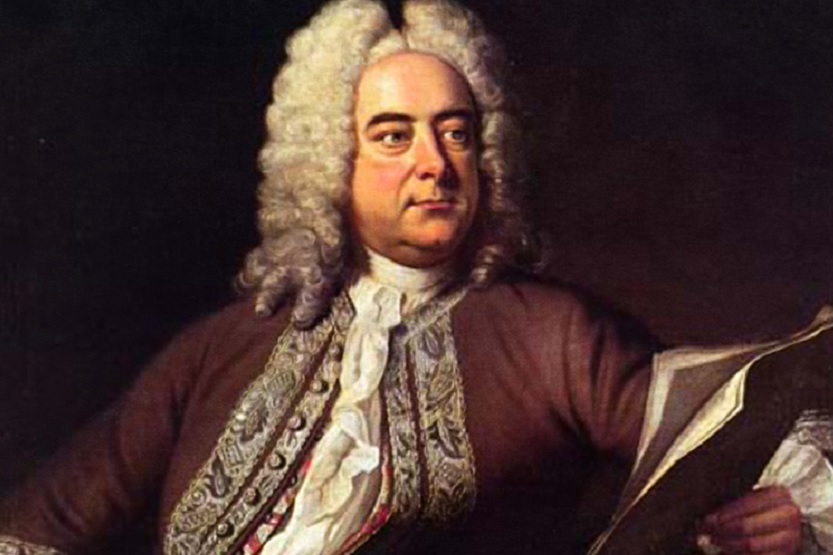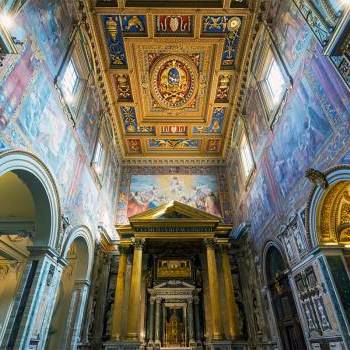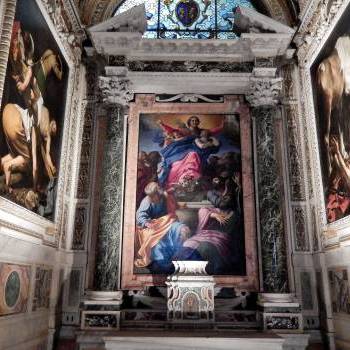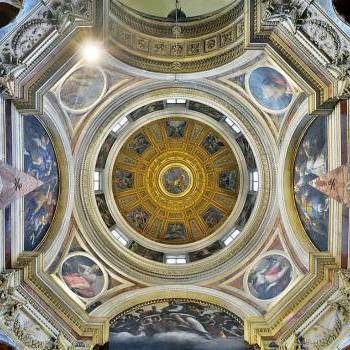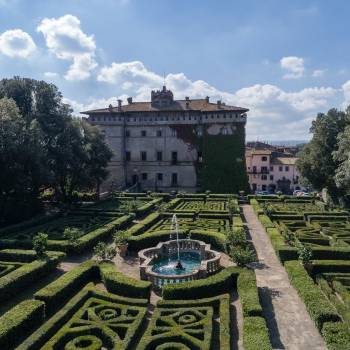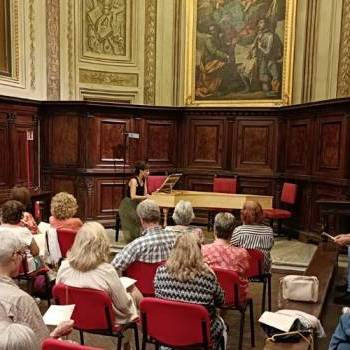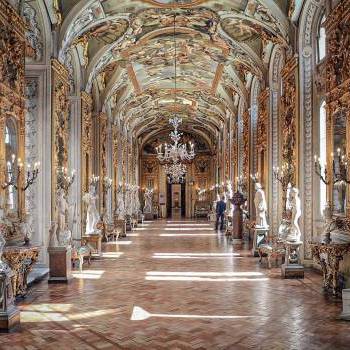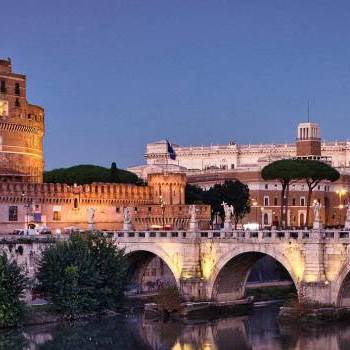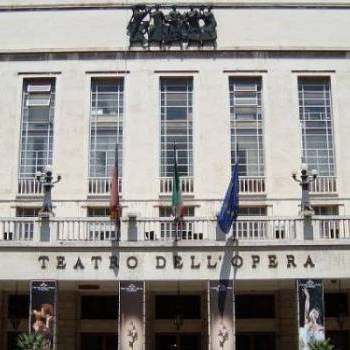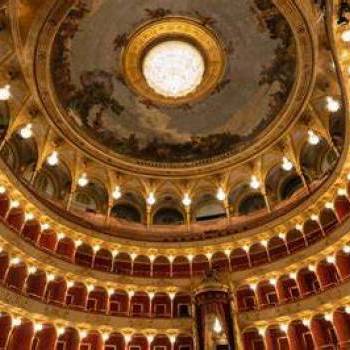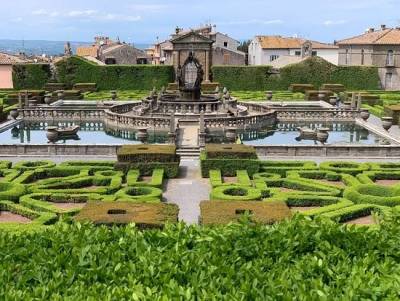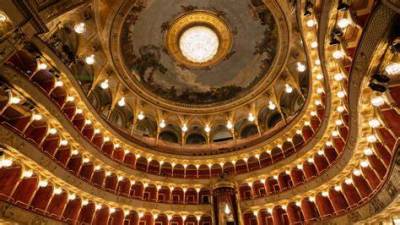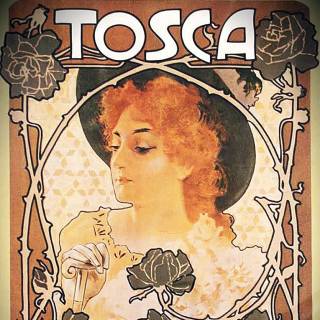
In the footsteps of Händel in Rome
An itinerary on the tracks of Händel in Rome
5 days / 4 nights - Travel idea
Suggested time: all year / possibility to combine it with an Opera at Teatro dell'Opera
Georg F. Händel moved to Rome in January 1707, a fundamental choice for his artistic training and production. The immersion in the aristocratic world, the competition of patrons in promoting the different forms of art, to be in contact with great musicians such as Scarlatti and Corelli, those are the elements creating the inspiration of his unmistakable musical work.
In this itinerary we will cover some of the most important stages of Händel's Roman stay. Discovering Piazza del Popolo and its Churches, a Chapel designed by Raffaello, great masterpieces by Caravaggio and several beauties around there, such as Basiliche e Battisteri. Oratorio dei Bergamaschi will be the great set for the Private Concert with enchanting suite and opera arias.
The first tresure linked to the creative genius of the music is Basilica of Santa Maria in Montesanto, followed by Palazzo Doria Pamphilj and Castello Ruspoli di Vignanello where Händel composed some cantatas dedicated to his host, Francesco Maria Ruspoli. Palazzo della Cancelleria became an important music life centre of Rome at that time thanks to many music performances and competions between artists.
To end the tour in the most bautiful way: enjoy a night at Teatro dell’Opera. Its rich season programme, great artists and directors enchant spectarors from all over the world.
Block notes:
- Haendel’s Places - Palazzo della Cancelleria, Palazzo Doria Pamphilj, San Giovanni in Laterano and Castello Ruspoli in Vignanello
- Music - Private concert in an Oratory in the heart of Rome
- Teatro dell’Opera di Roma - A night of great music in a beautiful theatre
Proposal for an indicative itinerary. The tour can be modified and adapted to any requests for further insights on topics chosen by the custom.
Day 1 - Arrival in Rome
Arrival in Romeby own means.
Accomodation in HOTEL 4* or 5*.
Free Dinner and overnight.
Day 2 - Rome
Breakfast in the hotel.
Morning: We are going to start our visit from Piazza del Popolo and its Churches: Santa Maria del Popolo with the Chigi Chapel designed by Raphael and the Cerasi Chapel which houses two great masterpieces by Caravaggio; Santa Maria dei Miracoli, Santa Maria in Montesanto. The Basilica of Santa Maria in Montesanto is part of the architectural tradition of the Roman Baroque and it links its name to some of the most important architects of the 17th century, the Rome of the great Papal Commissions. The project was carried out by the architect Carlo Rainaldi, followed by Carlo Fontana and Mattia De Rossi, under the supervision of Gian Lorenzo Bernini. His notoriety is also linked to the creative genius of the musician Georg Friedrich Händel who, in 1707, commissioned by Cardinal Carlo Colonna, composed psalms, motets and antiphons performed in this church for the Vespers of the Feast of Madonna del Carmine, in the evening of July 15, 1707.
Lunch in a selected Restaurant.
Afternoon: Following Händel’s footsteps we are going to visit Palazzo and Galleria Doria Pamphilj. Cardinal Benedetto Pamphilj spent time in this palace with literary figures, erudites and musicians including Mozart and Händel. The cardinal himself was the author of the libretto of the Oratory "The Triumph of Time and Disillusion" set to music by Händel himself. The Palace was built on the original nucleus of the residence of Cardinal Fazio Santoro dated to the early sixteenth century. Palazzo Doria Pamphilj is a concentrate of art and history, an history made of nobility, politics and unions between some of the greatest Italian noble families: from Della Rovere to Aldobrandini, from Pamphilj to Doria then Doria Pamphilj, to Facchinetti, Colonna, Borghese, Savoia.
Private Concert at the Oratorio dei Bergamaschi.
Voice and harpsichord.
Suite and opera arias from Alcina, Rinaldo and Giulio Cesare.
Free time for dinner and overnight.
Day 3 - Vignanello / Rome
Breakfast in the hotel.
Morning: Departure by bus to visit Castello Ruspoli di Vignanello (30km). The property was built around a fortress of the Benedictine monks built in the year 853, when this territory belonged to the Papal State. Beatrice Farnese was the first feudal lord in 1531. Five years later, after her death, Pope Paolo III Farnese confirmed the lineage to his daughter Ortensia, married to Sforza Marescotti. The castle, as it is seen today, was built in 1610 by Ottavia Orsini, Marcantonio Marescotti's wife. She has left an indelible trace of her love for this place: her initials and those of her two sons Sforza and Galeazzo, giving us the certain dating of the garden. The Castle name changed in 1704 becoming Ruspoli, with the obligation to pass on the name and today it is still the summer residence of the descendants of that family.
Here Händel was a guest of Francesco Maria Ruspoli and would have composed some cantatas dedicated to his host and the antiphon of “Salve Regina” for soprano solo, strings, organ and figured bass which was performed on July 16, 1707 in the Roman Church of Santa Maria in Montesanto in Piazza del Popolo.
At the end return to Rome and free lunch.
Afternoon: Visit of Basilica di San Giovanni in Laterano, Rome Cathedral. It was founded by Constantino between 313 and 318 with the title of Basilica Sanctissimi Salvatoris, secondarily dedicated to Saints John the Baptist and John the Evangelist, it was destroyed and rebuilt several times: the current Basilica dates back to the 17th century. The imposing travertine facade was built in 1735 by Alessandro Galilei, who won the contract following a public competition. In the right corner of Piazza San Giovanni in Laterano there is the Baptistery, built by Constantino in the place where, according to a consolidated but not historically reliable tradition, he was baptized by San Silvestro.
Free time for dinner and overnight.
Day 4 - Rome
Breakfast in hotel.
Morning: Visit to Palazzo della Cancelleria. Historic Headquarter of the Apostolic Chancellery, it still hosts the courts of the Vatican today. The palace, probably designed and partly completed between 1486 and 1496, is still the exclusive property of the Apostolic See. It was the first palace in Rome to be built from scratch in the Renaissance style and it is therefore considered one of the most beautiful buildings in the city. The long facade is of Florentine conception, comparable to Palazzo Rucellai. The large door was added in the 16th century by Domenico Fontana on the orders of Cardinal Alessandro Farnese. The portico was created by Donato Bramante and in the Hall of Honor there is a large fresco by Giorgio Vasari, completed in just 100 days, respecting the request of the client who had planned to use the hall for an upcoming wedding.
At the time of Cardinal Pietro Ottoboni, Palazzo della Cancelleria became an important music life centre of Rome. Between 1694 and 1705 several Oratories by Alessandro Scarlatti and various Chrtistmas cantatas were performed for the first time. In 1709 Ottoboni also ordered the construction of a theater, built by the architect Filippo Juvarra, but it was removed after his death.
A memorable musical competition between the Saxon G.F. Händel and the Neapolitan peer Domenico Scarlatti, son of the great Alessandro Scarlatti, was held in the presence of Cardinal Ottoboni at Palazzo della Cancelleria, in Rome, in 1708. It was an extraordinary evening, where two of the most virtuous harpsichordists of the time, performed improvisational feats on organ and harpsichord. (from J. Mainwering, Memoirs of the Life of the Late George Frederic Händel, London, 1760, pp. 51-52ss.)
Afternoon: Transfer by bus to TEATRO DELL’OPERA.
Return to the Hotel. Free time for dinner and overnight.
Day 5 -Departure
Breakfast in the hotel and check-out of the rooms.
Departure by own means.
The visits order may change for operational needs without changing the content.
Day 1 - Arrival in Rome
Arrival in Romeby own means. Accomodation in HOTEL 4* or 5*.
Free Dinner and overnight.
Day 2 - Rome
Breakfast in the hotel.
Morning: We are going to start our visit from Piazza del Popolo and its Churches: Santa Maria del Popolo with the Chigi Chapel designed by Raphael and the Cerasi Chapel which houses two great masterpieces by Caravaggio; Santa Maria dei Miracoli, Santa Maria in Montesanto. The Basilica of Santa Maria in Montesanto is part of the architectural tradition of the Roman Baroque and it links its name to some of the most important architects of the 17th century, the Rome of the great Papal Commissions. The project was carried out by the architect Carlo Rainaldi, followed by Carlo Fontana and Mattia De Rossi, under the supervision of Gian Lorenzo Bernini. His notoriety is also linked to the creative genius of the musician Georg Friedrich Händel who, in 1707, commissioned by Cardinal Carlo Colonna, composed psalms, motets and antiphons performed in this church for the Vespers of the Feast of Madonna del Carmine, in the evening of July 15,
1707.
Lunch in a selected Restaurant.
Afternoon: Following Händel’s footsteps we are going to visit Palazzo and Galleria Doria Pamphilj. Cardinal Benedetto Pamphilj spent time in this palace with literary figures, erudites and musicians including Mozart and Händel. The cardinal himself was the author of the libretto of the Oratory "The Triumph of Time and Disillusion" set to music by Händel himself. The Palace was built on the original nucleus of the residence of Cardinal Fazio Santoro dated to the early sixteenth century. Palazzo Doria Pamphilj is a concentrate of art and history, an history made of nobility, politics and unions between some of the greatest Italian noble families: from Della Rovere to Aldobrandini, from Pamphilj to Doria then Doria Pamphilj, to Facchinetti, Colonna, Borghese, Savoia.
Private Concert at the Oratorio dei Bergamaschi.
Voice and harpsichord.
Suite and opera arias from Alcina, Rinaldo and Giulio Cesare.
Free time for dinner and overnight.
Day 3 - Vignanello / Rome
Breakfast in the hotel.
Morning: Departure by bus to visit Castello Ruspoli di Vignanello (30km). The property was built around a fortress of the Benedictine monks built in the year 853, when this territory belonged to the Papal State. Beatrice Farnese was the first feudal lord in 1531. Five years later, after her death, Pope Paolo III Farnese confirmed the lineage to his daughter Ortensia, married to Sforza Marescotti. The castle, as it is seen today, was built in 1610 by Ottavia Orsini, Marcantonio Marescotti's wife. She has left an indelible trace of her love for this place: her initials and those of her two sons Sforza and Galeazzo, giving us the certain dating of the garden. The Castle name changed in 1704 becoming Ruspoli, with the obligation to pass on the name and today it is still the summer residence of the descendants of that family.
Here Händel was a guest of Francesco Maria Ruspoli and would have composed some cantatas dedicated to his host and the antiphon of “Salve Regina” for soprano solo, strings, organ and figured bass which was performed on July 16, 1707 in the Roman Church of Santa Maria in Montesanto in Piazza del Popolo.
At the end return to Rome and free lunch.
Afternoon: Visit of Basilica di San Giovanni in Laterano, Rome Cathedral. It was founded by Constantino between 313 and 318 with the title of Basilica Sanctissimi Salvatoris, secondarily dedicated to Saints John the Baptist and John the Evangelist, it was destroyed and rebuilt several times: the current Basilica dates back to the 17th century. The imposing travertine facade was built in 1735 by Alessandro Galilei, who won the contract following a public competition. In the right corner of Piazza San Giovanni in Laterano there is the Baptistery, built by Constantino in the place where, according to a consolidated but not historically reliable tradition, he was baptized by San Silvestro.
Free time for dinner and overnight.
Day 4 - Rome
Breakfast in hotel.
Morning: Visit to Palazzo della Cancelleria. Historic Headquarter of the Apostolic Chancellery, it still hosts the courts of the Vatican today. The palace, probably designed and partly completed between 1486 and 1496, is still the exclusive property of the Apostolic See. It was the first palace in Rome to be built from scratch in the Renaissance style and it is therefore considered one of the most beautiful buildings in the city. The long facade is of Florentine conception, comparable to Palazzo Rucellai. The large door was added in the 16th century by Domenico Fontana on the orders of Cardinal Alessandro Farnese. The portico was created by Donato Bramante and in the Hall of Honor there is a large fresco by Giorgio Vasari, completed in just 100 days, respecting the request of the client who had planned to use the hall for an upcoming wedding.
At the time of Cardinal Pietro Ottoboni, Palazzo della Cancelleria became an important music life centre of Rome. Between 1694 and 1705 several Oratories by Alessandro Scarlatti and various Chrtistmas cantatas were performed for the first time. In 1709 Ottoboni also ordered the construction of a theater, built by the architect Filippo Juvarra, but it was removed after his death.
A memorable musical competition between the Saxon G.F. Händel and the Neapolitan peer Domenico Scarlatti, son of the great Alessandro Scarlatti, was held in the presence of Cardinal Ottoboni at Palazzo della Cancelleria, in Rome, in 1708. It was an extraordinary evening, where two of the most virtuous harpsichordists of the time, performed improvisational feats on organ and harpsichord. (from J. Mainwering, Memoirs of the Life of the Late George Frederic Händel, London, 1760, pp. 51-52ss.)
Afternoon: Transfer by bus to TEATRO DELL’OPERA.
Return to the Hotel. Free time for dinner and overnight.
Day 5 -Departure
Breakfast in the hotel and check-out of the rooms.
Departure by own means.
The visits order may change for operational needs without changing the content.
Day 1 - Arrival in Rome
Arrival in Romeby own means.
Accomodation in HOTEL 4* or 5*.
Free Dinner and overnight.
Day 2 - Rome
Breakfast in the hotel.
Morning: We are going to start our visit from Piazza del Popolo and its Churches: Santa Maria del Popolo with the Chigi Chapel designed by Raphael and the Cerasi Chapel which houses two great masterpieces by Caravaggio; Santa Maria dei Miracoli, Santa Maria in Montesanto. The Basilica of Santa Maria in Montesanto is part of the architectural tradition of the Roman Baroque and it links its name to some of the most important architects of the 17th century, the Rome of the great Papal Commissions. The project was carried out by the architect Carlo Rainaldi, followed by Carlo Fontana and Mattia De Rossi, under the supervision of Gian Lorenzo Bernini. His notoriety is also linked to the creative genius of the musician Georg Friedrich Händel who, in 1707, commissioned by Cardinal Carlo Colonna, composed psalms, motets and antiphons performed in this church for the Vespers of the Feast of Madonna del Carmine, in the evening of July 15, 1707.
Lunch in a selected Restaurant.
Afternoon: Following Händel’s footsteps we are going to visit Palazzo and Galleria Doria Pamphilj. Cardinal Benedetto Pamphilj spent time in this palace with literary figures, erudites and musicians including Mozart and Händel. The cardinal himself was the author of the libretto of the Oratory "The Triumph of Time and Disillusion" set to music by Händel himself. The Palace was built on the original nucleus of the residence of Cardinal Fazio Santoro dated to the early sixteenth century. Palazzo Doria Pamphilj is a concentrate of art and history, an history made of nobility, politics and unions between some of the greatest Italian noble families: from Della Rovere to Aldobrandini, from Pamphilj to Doria then Doria Pamphilj, to Facchinetti, Colonna, Borghese, Savoia.
Private Concert at the Oratorio dei Bergamaschi.
Voice and harpsichord.
Suite and opera arias from Alcina, Rinaldo and Giulio Cesare.
Free time for dinner and overnight.
Day 3 - Vignanello / Rome
Breakfast in the hotel.
Morning: Departure by bus to visit Castello Ruspoli di Vignanello (30km). The property was built around a fortress of the Benedictine monks built in the year 853, when this territory belonged to the Papal State. Beatrice Farnese was the first feudal lord in 1531. Five years later, after her death, Pope Paolo III Farnese confirmed the lineage to his daughter Ortensia, married to Sforza Marescotti. The castle, as it is seen today, was built in 1610 by Ottavia Orsini, Marcantonio Marescotti's wife. She has left an indelible trace of her love for this place: her initials and those of her two sons Sforza and Galeazzo, giving us the certain dating of the garden. The Castle name changed in 1704 becoming Ruspoli, with the obligation to pass on the name and today it is still the summer residence of the descendants of that family.
Here Händel was a guest of Francesco Maria Ruspoli and would have composed some cantatas dedicated to his host and the antiphon of “Salve Regina” for soprano solo, strings, organ and figured bass which was performed on July 16, 1707 in the Roman Church of Santa Maria in Montesanto in Piazza del Popolo.
At the end return to Rome and free lunch.
Afternoon: Visit of Basilica di San Giovanni in Laterano, Rome Cathedral. It was founded by Constantino between 313 and 318 with the title of Basilica Sanctissimi Salvatoris, secondarily dedicated to Saints John the Baptist and John the Evangelist, it was destroyed and rebuilt several times: the current Basilica dates back to the 17th century. The imposing travertine facade was built in 1735 by Alessandro Galilei, who won the contract following a public competition. In the right corner of Piazza San Giovanni in Laterano there is the Baptistery, built by Constantino in the place where, according to a consolidated but not historically reliable tradition, he was baptized by San Silvestro.
Free time for dinner and overnight.
Day 4 - Rome
Breakfast in hotel.
Morning: Visit to Palazzo della Cancelleria. Historic Headquarter of the Apostolic Chancellery, it still hosts the courts of the Vatican today. The palace, probably designed and partly completed between 1486 and 1496, is still the exclusive property of the Apostolic See. It was the first palace in Rome to be built from scratch in the Renaissance style and it is therefore considered one of the most beautiful buildings in the city. The long facade is of Florentine conception, comparable to Palazzo Rucellai. The large door was added in the 16th century by Domenico Fontana on the orders of Cardinal Alessandro Farnese. The portico was created by Donato Bramante and in the Hall of Honor there is a large fresco by Giorgio Vasari, completed in just 100 days, respecting the request of the client who had planned to use the hall for an upcoming wedding.
At the time of Cardinal Pietro Ottoboni, Palazzo della Cancelleria became an important music life centre of Rome. Between 1694 and 1705 several Oratories by Alessandro Scarlatti and various Chrtistmas cantatas were performed for the first time. In 1709 Ottoboni also ordered the construction of a theater, built by the architect Filippo Juvarra, but it was removed after his death.
A memorable musical competition between the Saxon G.F. Händel and the Neapolitan peer Domenico Scarlatti, son of the great Alessandro Scarlatti, was held in the presence of Cardinal Ottoboni at Palazzo della Cancelleria, in Rome, in 1708. It was an extraordinary evening, where two of the most virtuous harpsichordists of the time, performed improvisational feats on organ and harpsichord. (from J. Mainwering, Memoirs of the Life of the Late George Frederic Händel, London, 1760, pp. 51-52ss.)
Afternoon: Transfer by bus to TEATRO DELL’OPERA.
Return to the Hotel. Free time for dinner and overnight.
Day 5 -Departure
Breakfast in the hotel and check-out of the rooms.
Departure by own means.
The visits order may change for operational needs without changing the content.
Day 1 - Arrival in Rome
Arrival in Romeby own means. Accomodation in HOTEL 4* or 5*.
Free Dinner and overnight.
Day 2 - Rome
Breakfast in the hotel.
Morning: We are going to start our visit from Piazza del Popolo and its Churches: Santa Maria del Popolo with the Chigi Chapel designed by Raphael and the Cerasi Chapel which houses two great masterpieces by Caravaggio; Santa Maria dei Miracoli, Santa Maria in Montesanto. The Basilica of Santa Maria in Montesanto is part of the architectural tradition of the Roman Baroque and it links its name to some of the most important architects of the 17th century, the Rome of the great Papal Commissions. The project was carried out by the architect Carlo Rainaldi, followed by Carlo Fontana and Mattia De Rossi, under the supervision of Gian Lorenzo Bernini. His notoriety is also linked to the creative genius of the musician Georg Friedrich Händel who, in 1707, commissioned by Cardinal Carlo Colonna, composed psalms, motets and antiphons performed in this church for the Vespers of the Feast of Madonna del Carmine, in the evening of July 15,
1707.
Lunch in a selected Restaurant.
Afternoon: Following Händel’s footsteps we are going to visit Palazzo and Galleria Doria Pamphilj. Cardinal Benedetto Pamphilj spent time in this palace with literary figures, erudites and musicians including Mozart and Händel. The cardinal himself was the author of the libretto of the Oratory "The Triumph of Time and Disillusion" set to music by Händel himself. The Palace was built on the original nucleus of the residence of Cardinal Fazio Santoro dated to the early sixteenth century. Palazzo Doria Pamphilj is a concentrate of art and history, an history made of nobility, politics and unions between some of the greatest Italian noble families: from Della Rovere to Aldobrandini, from Pamphilj to Doria then Doria Pamphilj, to Facchinetti, Colonna, Borghese, Savoia.
Private Concert at the Oratorio dei Bergamaschi.
Voice and harpsichord.
Suite and opera arias from Alcina, Rinaldo and Giulio Cesare.
Free time for dinner and overnight.
Day 3 - Vignanello / Rome
Breakfast in the hotel.
Morning: Departure by bus to visit Castello Ruspoli di Vignanello (30km). The property was built around a fortress of the Benedictine monks built in the year 853, when this territory belonged to the Papal State. Beatrice Farnese was the first feudal lord in 1531. Five years later, after her death, Pope Paolo III Farnese confirmed the lineage to his daughter Ortensia, married to Sforza Marescotti. The castle, as it is seen today, was built in 1610 by Ottavia Orsini, Marcantonio Marescotti's wife. She has left an indelible trace of her love for this place: her initials and those of her two sons Sforza and Galeazzo, giving us the certain dating of the garden. The Castle name changed in 1704 becoming Ruspoli, with the obligation to pass on the name and today it is still the summer residence of the descendants of that family.
Here Händel was a guest of Francesco Maria Ruspoli and would have composed some cantatas dedicated to his host and the antiphon of “Salve Regina” for soprano solo, strings, organ and figured bass which was performed on July 16, 1707 in the Roman Church of Santa Maria in Montesanto in Piazza del Popolo.
At the end return to Rome and free lunch.
Afternoon: Visit of Basilica di San Giovanni in Laterano, Rome Cathedral. It was founded by Constantino between 313 and 318 with the title of Basilica Sanctissimi Salvatoris, secondarily dedicated to Saints John the Baptist and John the Evangelist, it was destroyed and rebuilt several times: the current Basilica dates back to the 17th century. The imposing travertine facade was built in 1735 by Alessandro Galilei, who won the contract following a public competition. In the right corner of Piazza San Giovanni in Laterano there is the Baptistery, built by Constantino in the place where, according to a consolidated but not historically reliable tradition, he was baptized by San Silvestro.
Free time for dinner and overnight.
Day 4 - Rome
Breakfast in hotel.
Morning: Visit to Palazzo della Cancelleria. Historic Headquarter of the Apostolic Chancellery, it still hosts the courts of the Vatican today. The palace, probably designed and partly completed between 1486 and 1496, is still the exclusive property of the Apostolic See. It was the first palace in Rome to be built from scratch in the Renaissance style and it is therefore considered one of the most beautiful buildings in the city. The long facade is of Florentine conception, comparable to Palazzo Rucellai. The large door was added in the 16th century by Domenico Fontana on the orders of Cardinal Alessandro Farnese. The portico was created by Donato Bramante and in the Hall of Honor there is a large fresco by Giorgio Vasari, completed in just 100 days, respecting the request of the client who had planned to use the hall for an upcoming wedding.
At the time of Cardinal Pietro Ottoboni, Palazzo della Cancelleria became an important music life centre of Rome. Between 1694 and 1705 several Oratories by Alessandro Scarlatti and various Chrtistmas cantatas were performed for the first time. In 1709 Ottoboni also ordered the construction of a theater, built by the architect Filippo Juvarra, but it was removed after his death.
A memorable musical competition between the Saxon G.F. Händel and the Neapolitan peer Domenico Scarlatti, son of the great Alessandro Scarlatti, was held in the presence of Cardinal Ottoboni at Palazzo della Cancelleria, in Rome, in 1708. It was an extraordinary evening, where two of the most virtuous harpsichordists of the time, performed improvisational feats on organ and harpsichord. (from J. Mainwering, Memoirs of the Life of the Late George Frederic Händel, London, 1760, pp. 51-52ss.)
Afternoon: Transfer by bus to TEATRO DELL’OPERA.
Return to the Hotel. Free time for dinner and overnight.
Day 5 -Departure
Breakfast in the hotel and check-out of the rooms.
Departure by own means.
The visits order may change for operational needs without changing the content.
